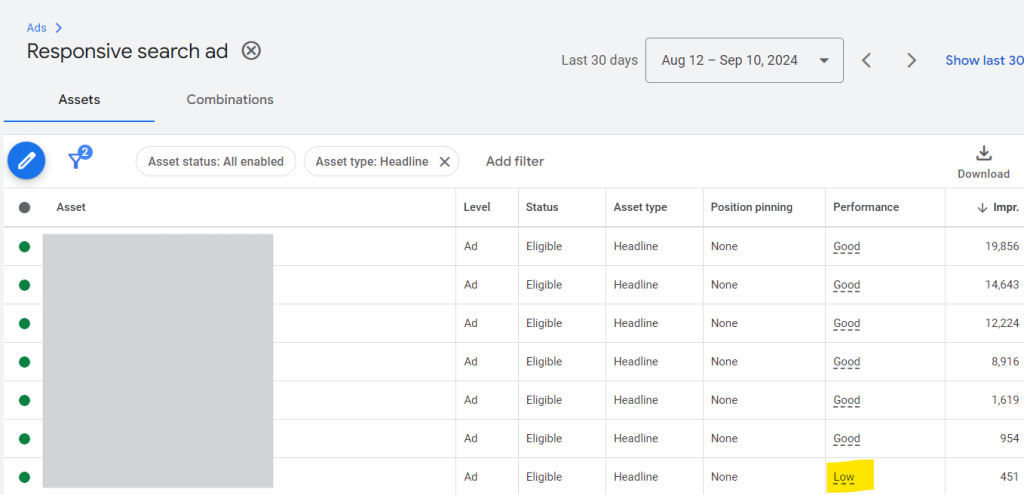Google’s responsive search ads (RSAs) can be hard to tackle.
If you follow Google’s recommendation and write 15 headlines and 4 descriptions, without pinning, a single RSA can show in 47,280 different variations (according to ChatGPT).
So how should advertisers test and optimize RSAs? How can we tell which element is working, and which isn’t?
In this article, I’ll go over some best practices to help you improve your ads’ performance.
- Understanding the Basics of Responsive Search Ads
- Advanced Testing Techniques for Headlines and Descriptions
- Experiment with Different Angles to Target Different Users
- Test Ads With Fewer Headlines And Descriptions
- Test Pinning Headlines to Specific Positions
- Utilize Headline and Description Assets
- Use Experiments
- View Asset Details To Replace Low-Performing Assets
- Monitoring and Analyzing Performance Metrics
- Adjusting Ad Rotation to Boost Impressions
- Key Metrics Over Quality Score
- Best Practices for Ongoing Optimization
- Conclusion
- Further Reading
Understanding the Basics of Responsive Search Ads
Responsive search ads include 5-15 headlines and 2-4 descriptions. Ads may show between 1-3 headlines and 1-2 descriptions, where the number of elements and their content is decided by Google Ads’ algorithm based on each query and user.
This results in an overwhelming number of possible variations – 47,280 (!) for a single ‘full’ RSA.

Benefits of RSAs
Google argues that RSAs can help tailor ads to each user with the highest chances of getting clicks and conversions.
With the help of AI and the actual performance data, the ads should optimize automatically over time to show the best headlines and descriptions, in the best order. This should improve results.
The more input you provide Google with, the more ad combinations it can test to find the best ones.
Problems with RSAs
Given the incredible number of ad variations, the algorithm’s learning may take a while. With smaller budgets, it may never have enough data to identify winning and losing ad combinations.
It’s also not clear that Google’s AI will give more visibility to your most important messages, or even give them a fair chance (as often happens with two ads running against each other).
And there are a few other problems that come along with random ads created by RSAs.
Firstly, if advertisers follow Google’s recommendations and avoid pinning headlines and descriptions, prospects might see ads that make little sense. Here are 2 examples (headlines):
- ‘20% Off In Sale – Buy Now’
- ‘Best Running Shoes – Order Online Today – Buy Now’.
The first example doesn’t include what we’re selling; in the second example, there are two repetitive CTAs.
To add to this lack of control over the message, advertisers have little visibility into which elements perform the best. Google Ads only provides an overview of which ad combinations showed how often, without any performance data.
So in order to better understand what’s working and what’s not and improve their results over time, advertisers must test their ads systematically.
Advanced Testing Techniques for Headlines and Descriptions
There are several approaches to testing RSAs. We’ll start with the classic one.
Experiment with Different Angles to Target Different Users
This is the classic ad test, where we test different ad content. Different angles of your product or service may speak to different users.
For example, let’s say you’re selling whey protein for gym goers. Some prospects may care more about the taste, while others focus on the product’s efficiency (how many grams of whey per serving). A third group may look for products with specific ingredients, whereas a fourth group may look for the best value for money.
Other common content tests:
- With or without a promotional message
- With or without social proof (‘thousands of happy customers’)
- Copy tests – brave, counterintuitive, new USPs
- Highlight edge over competition (in competitor campaigns)
- Title vs. sentence case
So you can define your angles, and craft different ads that specifically focus on a certain attribute or benefit.
Many Google Ads professionals today believe that ad content is the new targeting. By crafting different ads focusing on different angles, Google helps advertisers reach different users.
The better the match between a user’s query, your ad, and the landing page, the higher the chances of seeing great results.
Test Ads With Fewer Headlines And Descriptions
The more elements we provide Google with, the more freedom we give the algorithm to mix and match ad combinations. However, this freedom may dilute our most important messaging, or even create ads that read like complete gibberish.
So in order to narrow down the ad variations, a common test is to write ads with fewer headlines and descriptions. E.g., test a new ad with 5 headlines and 2 descriptions, against a ‘full’ ad with 15 headlines and 4 descriptions. Of course, you can also test any other number of elements that makes sense to you.
I usually duplicate the original ad and trim it down. The first thing I’m looking for is duplicate and repetitive messages, then I’d remove ‘filler’, less important headlines.

Test Pinning Headlines to Specific Positions
Another way to better control how our ads show is to pin some elements to certain positions.
While pinning an element doesn’t necessarily mean it will show in all ad combinations, it ensures that it will show in a specific position when it does.
Here’s how I like to do this:
- Position 1: The main product or value proposition
- Position 2: USPs
- Position 3: CTAs, brand name, and less important headlines
Remember that ads can also show with only 1 headline and 1 description, so these should include your most important message. That is usually what you’re selling.
It’s estimated that only 30% of responsive search ads include 3 headlines. So it’s better to keep this position for the less important messages.
Note that Google doesn’t recommend pinning, and doing this will impact the ad strength. However, ad strength doesn’t play a major role in predicting the performance of your ads.
A poor ad strength often means Google will show your ad less often than ads with better quality. In this case, consider changing the campaign ad rotation settings from ‘prefer best performing ads’ to ‘even ad rotation’, for the duration of your test.

Utilize Headline and Description Assets
Another way to test specific headlines and descriptions is by utilizing the headline and description assets.
Advertisers can schedule them and pin them to position 1 or 2 to make sure that they show. Let this test run for 2-4 weeks, then look back and compare performance before and after.
This approach has 2 main advantages: isolating a single element and testing its impact on performance; not affecting the learning of the ads, which isn’t the case when you create new ads or make changes to existing ones.
On the other hand, this feature also has its caveats: it can only be applied at the campaign level. This means, if you’d like to test a new USP in position 2, it will affect all active ads in the campaign.
Also, a before and after test isn’t a perfect AB test, as it’s affected by micro-seasonality, automatic bid adjustments (by the algo), and many other moving parts.

Use Experiments
Experiments are a built-in tool within the Google Ads UI.
This tool allows you to duplicate a base campaign, make changes to the copy (trial arm), and let the 2 campaign versions run alongside for the test duration.
So in our case, advertisers can duplicate a campaign, and then create new ads in the trial arm.
This is the closest option to a pure AB test in Google ads.
Just note that the trial campaign will behave as a new campaign, and will need some time to ramp up learnings and optimize. This means, ideally your test should run for at least 30 days.
View Asset Details To Replace Low-Performing Assets
In the Ads view, there’s a small link to ‘view assets details’ under each ad. Clicking on it will show 2 reports: Assets, and Combinations.
The Assets report will expose how many impressions each element received, and a performance score – low, good, or best.
You can use this report to replace or remove low-performing headlines and descriptions.
The combinations report will show the ad combinations with the most impressions. You can use it to draw insights into how many headlines and descriptions show in most ads, and also which images and sitelinks.
If you feel like something is off (e.g. not the ideal headline showing in position 1, or repetitive headlines), you can change the ads accordingly.
Unfortunately, these reports are only available on the ad level, so if you have many campaigns, ad groups, and ads, you should start analyzing the top spending campaigns first.

Monitoring and Analyzing Performance Metrics
Once you’ve set up your responsive search ads test, give it enough time to collect data. Depending on the budget and spend level, the ideal testing time should be at least 2 weeks, but a full month is also common.
Adjusting Ad Rotation to Boost Impressions
Check your new ads shortly after setting up your test. In case they don’t spend, or spend little in comparison to the older ads, you can change the ad rotation settings of the campaign from ‘prefer best performing ads’ to ‘rotate ads indefinitely’.
This will ensure the new ads get a fair chance.
Key Metrics Over Quality Score
When you analyze your test results, it’s important to focus on the right metrics: CTR (better CTR often correlates with better CVR), CPA, and ROAS.
Make sure to account for the average conversion window in the ad account. If the test ended yesterday and many conversions only take place 7 days after a click, wait for this period to pass before you draw any conclusions.
Ad strength isn’t as important and is based on Google’s recommendations to add as many headlines and descriptions that refer to the keywords in the ad group, and without pinning.
However, ad strength doesn’t affect the ad rank significantly (though it will give more visibility to ads with higher quality).
Best Practices for Ongoing Optimization
Optimizing responsive search ads is an ongoing process.
Here are a few guidelines I use in my accounts:
- Don’t make changes too soon: Allow the new ads enough time to learn. At least 2 weeks, but 30 days are even better. During that time, try to make as little changes to the test campaign / ad group as possible. Only make changes if your new ad doesn’t get any traffic, or once you identify clear winning or losing ads.
- Test small: Select ad groups with enough data to test in. Start with 1-5 ad groups, and if the new ads turn out to win the test, roll them out to more relevant ad groups gradually.
- Keep ads with similar performance on: If two ads perform similarly, consider leaving both active since they may serve different audiences effectively.
Conclusion
Responsive search ads can leverage Google’s AI to show the best ad combination per search query, user, device, and time.
However, it’s hard to identify which elements work best and which ones are poor, and for Google’s AI to work its magic it will need a whole lot of data and ad spend.
By systematically testing RSAs, you can identify what works and what doesn’t, and improve your account’s performance over time.
Further Reading
- New On Google Ads: Headline and Description Assets
- Mastering A/B Testing in Google Ads: Strategies for Optimal Results
- Can YouTube Ads Drive Ecommerce Sales?
- 8 Ways to Scale Performance Max Campaigns For ECommerce
- Examples of Using ChatGPT for Google Ads
- Demand Gen: Google Ads Version of Paid Social Campaigns?

